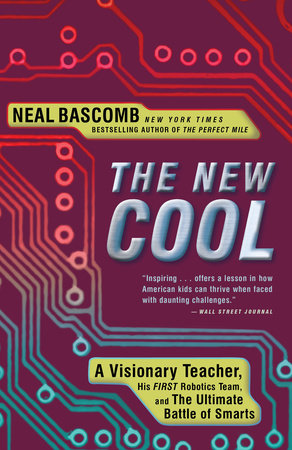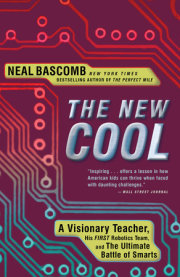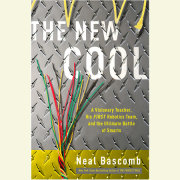The Kickoff
The robot is just a vehicle, just a tool. —DEAN KAMEN
At 4:30 A.M., Saturday, January 3, a white Toyota Matrix was alone on Highway 101, heading south along the Pacific coastline. Its headlights carved a tunnel through the darkness. With one hand on the wheel, Amir Abo-Shaeer drove as fast as he could without getting caught in any speed traps. He wore his usual uniform of old sneakers, cargo shorts, a black sweatshirt, and a FIRST baseball cap.
The son of an Iraqi theoretical physicist and an Irish Catholic from Pennsylvania, Amir was a thirty-seven-year-old teacher at Dos Pueblos High School in Goleta, California, and the founder of its engineering academy. He was tall and scarecrow thin, with neatly trimmed dark hair and an almost permanent five o'clock shadow. Small round glasses framed his deeply set brown eyes.
His wife, Emily West, a contrast of blond hair and fair skin, sat in the passenger seat. She came from a Mormon family, her youth split between Utah and California. In the backseat were two seniors from Amir's academy. John Kim had immigrated to the United States from South Korea with his family when he was twelve. His father was a professor of chemical engineering. John spoke a stilted English and still had memories of the instructors at his Seoul grade school beating him with a bat for misbehaving. Beside him sat Kevin Wojcik, a pimpley-faced, athletic seventeen-year-old of Polish descent whose father cleaned pools for a living.
This only-in-America crew was on its way to a kickoff event in Los Angeles for the 2009 FIRST Robotics season. The four of them would watch a live, NASA-streamed webcast of the big show in New Hampshire that would reveal the new season's game. Then they would pick up their kit of parts, the true purpose for their early-morning journey. In six weeks, Amir and his thirty-one students, most of whom were still asleep back in Goleta, a town just west of Santa Barbara, would have to build a robot ready to compete against 1,685 other teams in a game that had never before been played.
No matter what kind of game FIRST announced, their robot would have some essential elements, starting with an ability to move around the field of play. This did not mean legs of the C-3PO variety but rather wheeled motion. Their robot would need mechanisms to perform the tasks set out in this year's game, perhaps retractable arms or maybe a catapult. It would also include sensors, such as a meter to gauge how fast its wheels were turning or a camera to detect a target. The robot would require an electrical system that could relay information coming from the sensors and deliver energy from the battery to the motors driving the wheels and other mechanisms. This electrical system was like a body's nervous and circulatory systems combined. Finally, the robot would need a brain supplied with computer code. This brain would process the information coming from the sensors and allow the robot to both operate on its own and translate the wireless joystick commands from its drivers into action.
The kit Amir and his students would pick up would provide a starting point but no more than that. Building the robot would demand long hours and undoubtedly challenge his students as they had never been challenged before.
Unlike every other team in the FIRST competition, Dos Pueblos was made up of only seniors, all of whom received academic credit for their participation. They were all robotics rookies, and their season would be the capstone course at the academy where Amir was trying to create a new model for education, one grounded in real-world, project-based, interactive learning. In six weeks he needed to teach this hodgepodge group of kids how to design, machine, construct, wire, and program a robot, while bringing them together as a team for competition. Their success would prove that what he was doing in his academy was working.
Amir was always teaching, and as they drove down Highway 101, he showed Kevin and John how to predict dips in the road. He turned on his brights, pointed out a dark patch of concrete in the middle of the road ahead, and told them to wait. A second later they hit a dip. He explained that after a car hits one, any oil leaked from the engine shakes off onto the pavement. Repeated day after day by thousands of cars, this leaves a large stain on the road after a dip.
"Cool," Kevin said, but what he wanted to talk about was what kind of game Amir expected for this season. When Amir wouldn't dare a guess, Kevin and John joked that it would be some kind of contest where the robots had to swim underwater.
"No way it'll be a water game," Amir said, shaking his head and laughing. Emily sat quietly, suffering from morning sickness but saying nothing because her pregnancy, their first, was still a secret.
As they approached Los Angeles, Amir grew increasingly excited. Yes, he was eager to engage his students in this formative experience. But there was also a part of him, the one that at his age still competed in a head-to-head LEGO-building contest every Christmas with his brother (who had a Ph.D. in experimental physics from MIT), that was personally thrilled about the new engineering challenge ahead. It's finally here, he thought.
As Amir pulled in to the University of Southern California campus in Los Angeles for the kickoff event, Gabe Rives-Corbett, a member of the Dos Pueblos Engineering Academy team, arrived at a salmon-colored office building near Goleta's sparse downtown. A thick coastal fog hung like a pall over the dark streets at that early hour. Gabe, whom some on the team considered their best hope because of his programming skills, was a goofy-looking kid: slightly overweight, with a round face, a mop of unkempt brown hair, a large, dark birthmark on his neck, and a grin that had provocateur written all over it. That grin, however, was nowhere to be seen because Gabe was still half-asleep, having awakened less than a half hour before.
Yawning repeatedly, he lugged his laptop across the parking lot and through the columned entrance of Moseley Associates, a wireless-technology company run by a teammate's father. The place was swank, with marble floors, glass doors, a grand staircase, and high cathedral ceilings. Security cameras followed Gabe as he walked down a corridor and through a set of double doors into a huge, two-story auditorium, where the rest of his team was gathered around a U-shaped table in front of a projection screen. They were a motley bunch of high school seniors: boys, girls, tall, short, big, thin, athletic and not, cool, nerdy, white, Hispanic, Asian, Middle Eastern, boisterous, sheepish, striking, plain, hiply dressed, and shapeless in hoodies and sweatpants.
Nobody was saying much, but the nervous energy in the auditorium gave Gabe a jolt. He sat down next to one of his teammates, who said, "This is awesome." As the minutes ticked down for the kickoff webcast to begin, Gabe, a former tae kwon do champion, felt the same tight pit in the bottom of his stomach that he felt when he was about to go into a fight.
Another of his teammates, Anthony Turk, who gave the impression of a teddy bear with his roly-poly form and easy, warm smile, had a different sense: fancy place, a diverse group with different skills assembled, everyone hyped to learn of their improbably complicated mission. "It's like Ocean's Eleven," he said. "And we're about to rob the Bellagio."
On the other side of the country, the sun was already up and a light snow was falling. Those assembled inside the Southern New Hampshire University Field House felt like kids on Christmas morning as they waited for the FIRST Kickoff to begin. Veterans knew there would be a lot of speeches--there was a message to spread--but the game was why most had come in person, to walk the new field, feel the new game pieces, and open the new kits as soon as possible. The NASA simulcast was great for those who couldn't be here, but for those living close enough to Manchester, or with the means to make the trip, seeing the field and everything else firsthand gave them an advantage, if slight, in understanding the new game. In this competition, teams seized every advantage they could.
High school kids and their mentors packed the field house. A stage was set on the auditorium floor with a podium, a projection screen, and two pairs of stands filled with students to serve as a backdrop for the cameras. This was a professional production: soundboards, klieg lights, a master of ceremonies advising everyone to smile and look pretty, and even someone to lead the audience on when and how to make the appropriate ruckus.
There was nothing manufactured about the crowd's eagerness, however--the shaking legs, the last-minute attempts to decipher the obtuse clues FIRST had provided prior to the event, and the staring at the long curtain of cloth hiding the new playfield as if by doing so they could somehow acquire X-ray vision.
The game could be anything. In 1992, the inaugural competition, four 24-pound robots had to move about a square field layered with corn kernels, collecting multicolored tennis balls of varying point values. In 1995, there was a T-shaped carpeted field with platforms and slopes where robots competed to place 24-inch and 30-inch balls through field goals. Subsequent years featured inner tubes, hexagonal fields, more balls, 50-, then 70-, then 120-, then 130-, then back to 120-pound robots, pneumatic arms, turreted shooters, human players who could score points along with the human-controlled robots, octagonal platforms that rolled on casters, ramps to mount, and tetrahedrons to stack. In 2006, robots needed to herd foam balls into corner goals as well as shoot them through a stationary 10½-foot-tall circular target. In 2008, robots ran laps around a track while maneuvering large exercise balls over and under a 6-foot-high overpass bisecting the course. At the very least, FIRST's game designers had shown a Dali-esque bent for originality.
At 10 A.M. sharp, the countdown began. The lights dimmed, and the broadcast went live. The projection screen filled with snapshots of kids in various states of euphoric cheering. Then words flashed on a black screen with a Star Trek-style swoosh of sound effects:
In an earlier transformative era in American history . . . President John F. Kennedy challenged our nation . . . To land on the moon within 10 years . . . Eight years and two months later . . . Neil Armstrong set foot on the lunar surface . . . The average age of the engineers cheering Apollo 11 that day . . . Was 26 . . . Which means their average age at the time of the challenge . . . Was 18.
Fast music blared. More snapshots of kids pumping their fists on the screen. A call to action. "Assemble your crew. Prepare for liftoff. The world is watching. Expectations are high. Duty is calling. Be the answer. One first step changed the world. Your leap can make history." The screen darkened. Big cheers followed in the stands. The lights brightened to show John Abele, FIRST chairman and cofounder of Boston Scientific, at the podium to make some welcoming remarks.
While he spoke about the glorious triumph of the Apollo moon landing, its fortieth anniversary that year, everyone awaited the entrance of Dean Kamen. For these students and mentors he was the star attraction, and a certain sign the game would soon be revealed.
On the morning of the kickoff, Dean Kamen awakened a little groggy in his hilltop mansion, Westwind. Early morning was not his favorite part of the day.
Usually he didn't leave his office until 9 or 10 P.M. With a few of his engineers in tow, he would grab dinner, his one real meal of the day, before coming home to do more work, whether it was mulling over a design problem, tinkering in his shop, or talking with one of his frequent guests, many of whom ended up staying overnight. Dean wouldn't go to bed until he was so tired that he knew the second he slipped under the covers he would be out. No sense in wasting minutes counting sheep. The sole difference the night before the kickoff was that he had left the office early to host an event at his house for FIRST. The night went typically late.
Dean treated his few hundred guests, mostly team mentors from around the country, to a boy's dream of a home. These teachers and engineers, the bedrock of the FIRST community, looked about in wonder, uttering "Wow" and "Cool" and "Sweet." At 20,000-plus square feet, it was the biggest house most of them had ever seen, let alone been inside. More amazing, Westwind was one of a kind, a shrine to the magic of invention.
The hexagonal house was set on a steep hill, the highest spot Dean could find between Manchester and Boston. Its centerpiece, the form around which Dean designed the house, was a steamboat engine previously owned by one of his heroes, Henry Ford. The 25-ton, three-story marvel, a beautifully curved hulk of metal that Dean had rebuilt, bolt by bolt, was proof that engineering was art. The house, a labyrinth of rooms, levels, and passageways (some cut straight out of the hill's black rock), muddled one's sense of direction.
Getting lost long enough, a visitor might discover a professional-grade machine shop; an indoor swimming pool; the elevator from the set of The Sting; countless bedrooms and bathrooms; a chess-playing robot named the Turk; the first flight simulator; a 1913 Model T; jukeboxes; slot machines; Einstein portraits; a hangar with two helicopters; an exercise room; a sauna; a garage housing a black military Humvee, a Porsche 928, an electric Tesla Roadster; a cupola from which to watch the weather shift or planes taking off at the local airport; two pulley systems to deliver bottles from the wine cellar; and a secret corridor leading from the wood-paneled library, opened by pulling at the spine of Ingenious Mechanisms for Designs and Inventions, volume 4. A 150-foot windmill powered the house, and a 3.8-million-gallon pond, which Dean had created by blasting out rock and dirt from the hillside, supplied his water. For physical activity, the estate boasted a floodlit baseball diamond and tennis court.
Some likened Dean to Willy Wonka. He possessed the fantastic house and more than enough of the eccentricities. The morning of the kickoff, he put on one of his more than two dozen identical outfits: blue jeans, a blue-denim shirt, and work boots. There was a tuxedo in the closet as well, but he hadn't even worn that when he attended an event at the White House. From his bedroom, he walked down a spiral staircase and through a doorway into the kitchen to have his coffee. An overnight guest waiting for him there would have been puzzled to see Dean emerge from the cupboard, as if he had spent the night cramped inside. Dean had the door leading to his bedroom designed to look like his kitchen cabinets.
Copyright © 2011 by Neal Bascomb. All rights reserved. No part of this excerpt may be reproduced or reprinted without permission in writing from the publisher.










